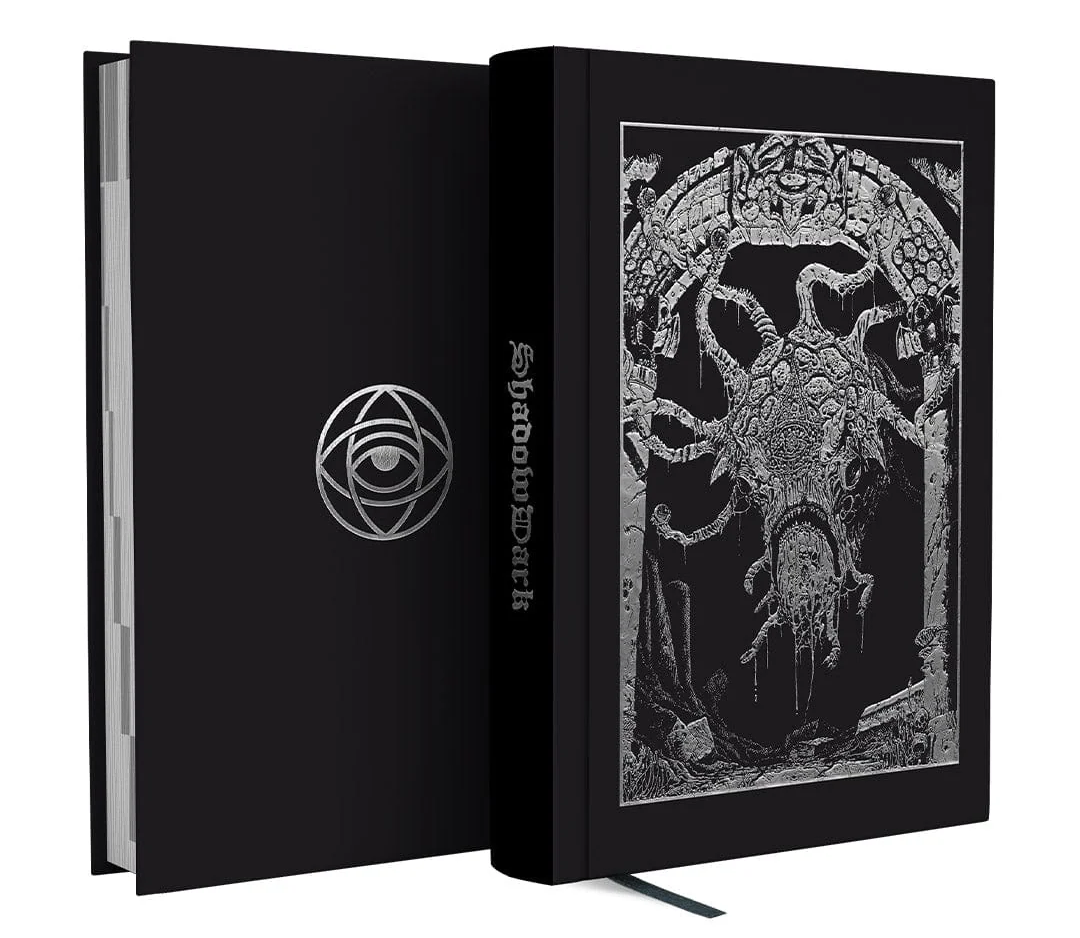In Shadowdark, the dark dangers of the dungeon are infamously made tangible at the gaming table by linking the duration of light sources to real time: Have you been playing for an hour? Then your torches, lanterns, and light spells burn out and you’ll need to ready new light sources.
This is a mechanic that streamlines bookkeeping, centers expedition-based play, and encourages fast-paced action. (If you sit around dithering, then you’re literally burning the candle at both ends!) It can also be a controversial mechanic due to its lightly dissociated nature, so it’s ultimately up to you whether the visceral immersion of the real-world time pressure is worth the tradeoff.
DARKER DEPTHS
But we can take this concept even further by embracing the ideal of the Mythic Underworld. Within those strange depths, the darkness does not flee the light, but rather turns upon it. Crawling through those tunnels you can feel it pressing in — little eddies of shadow testing the flickering weakness of your torch until finally the stygian murk literally snuffs out any source of light.
And the deeper you dare? The stronger the darkness becomes.
If you’re on the first level of the dungeon, then torches, lanterns, light spells, and other sources of illumination have a duration of 1 hour. But as you descend to lower levels of the dungeon, light source duration decreases as shown on the table below:
| Dungeon Level | Light |
|---|---|
| 1 | 1 hour |
| 2 | 50 minutes |
| 3 | 40 minutes |
| 4 | 30 minutes |
| 5 | 25 minutes |
| 6 | 20 minutes |
| 7 | 15 minutes |
| 8+ | 10 minutes |
If the PCs switch dungeon levels in the middle of a duration, increase or decrease the end time of the light source appropriately. For example, if a torch was going to burn out at 8:50 pm and the PCs descend from Level 1 to Level 2, the torch should now burn out at 8:40 pm. (Going up a level should always relieve pressure; going down should always increase it, and could even cause a torch to immediately go out!)
Sublevels can be treated as a level of equivalent depth (e.g., Level 3A would have the same light duration as Level 3).
DESIGN NOTES
The rules for darker depths are, obviously, designed to increase the stakes and costs of mounting expeditions to lower (and, in classic megadungeon play, more profitable) levels of the dungeon. In more narrative-driven dungeons (e.g., we must follow the dragon into the depths to recover our comrade’s body!) where the logistics of torch management may not be a primary focus, it will nevertheless push a sense of rising dread and danger.
Big, ten-minute chunks are taken out of the time initially so that the players can immediately feel the difference from one dungeon level to the next. Once the timer reaches 30 minutes, this pace is reduced to five minutes per level in order to sustain the effect for larger dungeons.
Similarly, the progression is ultimately capped at 10 minutes per light source because shorter durations (e.g., 5 minutes or 1 minute) simply become too much of a hassle to implement, serving as more of an annoying distraction than a terrifying reality.
You could experiment with the idea that, beyond Level 8, the stygian depths actually prevent any light source from being ignited, but this would obviously represent a fundamental shift in the paradigm of play rather than simply putting pressure on the existing forms of play.














Looks like the table has a slightly dissociated nature
@Rpg Dad: Wow. You can read. We’re all very impressed.
You guys can see the table?
Love the concept! I’m gonna be using it in my next Shadowdark game!
I think RogDad is saying that the table isn’t rendering. I don’t see it either.
Yep, no table for me.
I don’t quite understand the point of light saving time. It seems focused solely on ensuring players don’t waste time talking. Because if the only thing that counts is real time, it’s exactly the same whether the characters rush (in-game) or proceed with caution. For example, if the players say “we spent an hour thoroughly exploring this room,” the GM roll the dice and only 2 minutes of real time have passed. Where’s the “in-game” pressure? It doesn’t exist, or it bears no relation to the real pressure the players feel.
And a big fight can last an hour, and the lights go out when, in the PCs’ time, they’ve only spent 2 minutes fighting.
Fun idea. This lends itself incredibly well to the Angry GM’s time pool mechanic. When actions that take an appreciable amount of time, including scrounging, resting, and traveling, rolling a die representing a torch. On a 1, the light goes out. Additional dice could be added per floor depth, with any 1 having said effect.
@Rpg Dad
I am also not seeing the table, though we can infer from the text that it reads L1 – 60 min | L2 – 50 min | L3 – 40 min | L4 – 30 min | L5 – 25 min | L6 – 20 min | L7 – 15 min | L8 or deeper – 10 min
@z666
In those cases, Shadowdark has a rule called “Time Passes” where… time passes haha. Basically, if the players say “we’re gonna do this for 10 minutes,” all the torch timers decrease by 10 minutes, and so on. Since searching the room manually would probably take less than 10 minutes for an efficient party, and any more in depth interaction/planning/etc. will still take up time (in addition to the 10 minutes that passed), this serves to make manual exploration more efficient in general.
You are correct that this system also discourages combat! Though Shadowdark combat does run pretty fast.
Both of these are great for an OSR game, where manually describing how you explore is a huge part of play, and combat should generally be seen as a fail state (or at least not a dangerous and costly endeavor).
z666@4: My impression is that the purpose of the torch timer rule is not to stop players from talking specifically, but to create pressure in general — to keep everyone aware that they’re in a dangerous place. Using real time instead of game time is a kludge, but I think it’s a brilliant one. Trying to account “correctly” for game time to the minute is almost hopelessly difficult, especially for a new DM, while setting a timer on the table is just a single action, and it can even sound an alarm to remind you when time is up. If sometimes your torches burn out “too fast” because you were in combat, well, I guess you dropped it in a puddle. You were in combat, after all.
It’s clear from at least a few responses above that the commenter hasn’t played the game or has a pretty profound misunderstanding of the rules.
I think the idea in the article is a fun one and certainly could be a way to ramp up the resource management aspect of ShadowDark by demanding that extra torches are taken for deeper dungeons.
In my experience with the game (about 2 years of pretty consistent play), the torch timer’s duration is less of an issue than the frequency of random encounters which is recommended to increase commensurate with the depth of the dungeon (ie., 1 in 6 becomes 2 in 6). Spending time trying to plan how to avoid the troll coming down the hall eats awat at time. Negotiations with the random elven merchant you encounter takes time. However, these are all actual play events rather than hand waves.
Again, I think the Alexandrian’s idea has merit and would be a lot of fun for some tables; however, the commentors above who are questioning the real-time mechanic itself really should give the game a try as written. The torch timer creates a really interesting mechanism to engage with that feels grounded in the game experience. Lastly, if your combats in ShadowDark are lasting an hour those are some massive and complex battles. Rarely do ShadowDark combats last that long. Like most OSR games, combats tend to be decisive and bloody.
I’ve reinitialized the table. Hopefully it’s working for everyone again.
Okay, I understand better now, thanks for the explanations. However, for me, it’s too much. I’d have a hard time accepting things like the fact that we can’t light two torches. I suppose it would be possible if the group splits up. In fact, if the group splits up and each subgroup carries a torch, if the master spends 10 minutes with one of the groups, does the time also pass for the other?
@z666: Yes, indeed. This soft time pressure plus random encounter checks every 2 turns makes ShadowDark play extremely quick and fluid. There is a completely free starter set with the necessary rules and a dungeon written for it, it’s good!
Also remember that starting equipment is 2 torches, some characters can cast light, and the typical session is 3-4 hours of real time.
So, the point in Shadowdark using real time torches is to lighten the workload on the DM. You simply look at a clock and make a mental note of when the torch goes out assuming it lasts the whole 60 minutes. It is highly recommended that you add events that threaten the parties light source to your random tables. A sudden rush of air blowing it out. Dirt or water falling from the ceiling to extinguish it. A surprise animal or monster running by. Most call for a dex save to keep the light source safe. While we constantly encourage the players to take notes, and the point of real time is to take a little record keeping off the DM, as the DM it is always good to take notes yourself. A simple note of *player* “time” when torch goes out is helpful, especially in the case of split parties. And frequently, a split party with an encounter in this format turns deadly.
@AG why can’t you light 2 torches? I let my players do this all the time. Torches cost money, take up lots of space, and require a hand that could be used for a shield or 2 handed attack.
The mechanic is really cool in delving centric games. It naturally curbs the table talk to game centric talk. It is often said at my table, “ok, but my torch is burning down” to get players back on track.
Maybe just use real torches at the table.
If the players doddle, set their character sheets on fire.